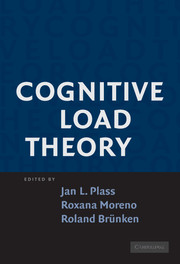Book contents
- Frontmatter
- Contents
- Contributors
- COGNITIVE LOAD THEORY
- Introduction
- PART ONE THEORY
- 1 Cognitive Load Theory: Historical Development and Relation to Other Theories
- 2 Cognitive Load Theory: Recent Theoretical Advances
- 3 Schema Acquisition and Sources of Cognitive Load
- 4 Individual Differences and Cognitive Load Theory
- PART TWO EMPIRICAL EVIDENCE
- PART THREE DISCUSSION
- Index
- References
4 - Individual Differences and Cognitive Load Theory
Published online by Cambridge University Press: 05 June 2012
- Frontmatter
- Contents
- Contributors
- COGNITIVE LOAD THEORY
- Introduction
- PART ONE THEORY
- 1 Cognitive Load Theory: Historical Development and Relation to Other Theories
- 2 Cognitive Load Theory: Recent Theoretical Advances
- 3 Schema Acquisition and Sources of Cognitive Load
- 4 Individual Differences and Cognitive Load Theory
- PART TWO EMPIRICAL EVIDENCE
- PART THREE DISCUSSION
- Index
- References
Summary
The previous chapters discussed sources of cognitive load that are a result of the difficulty of the materials, the design of instruction, and the amount of mental effort invested by learners to process the new information. As outlined in these chapters, the major cause of cognitive load effects is the limited capacity of working memory. In this chapter, we discuss how individual differences relate to the level of cognitive load that a particular learner experiences.
Individual differences in learner characteristics take many different forms, ranging from preferences for learning from different presentation formats (e.g., verbal, pictorial) or modalities (auditory, visual, haptic) and preferences for learning under different environmental conditions (e.g., lighting, noise level, or physical position) to cognitive styles (e.g., field dependency/independency), cognitive abilities (e.g., verbal, spatial ability), and intelligence (Carroll, 1993; Jonassen & Grabowski, 1993). The influence of individual differences on learning has been studied for several decades as aptitude-treatment interactions (ATIs; Cronbach & Snow, 1977; Leutner, 1992; Lohman, 1986; Mayer, Stiehl, & Greeno, 1975; Plass, Chun, Mayer, & Leutner, 1998; Shute, 1992; Snow, 1989, 1994; Snow & Lohman, 1984, 1989). Aptitude-treatment interactions occur when different instructional treatment conditions result in differential learning outcomes depending on student aptitudes, in other words, when the effect of a given treatment is moderated by a given aptitude. Different aptitudes may influence learning in specific instructional environments, and the impact of a particular aptitude on a particular condition may only be observed for a particular type of learning outcome.
- Type
- Chapter
- Information
- Cognitive Load Theory , pp. 65 - 88Publisher: Cambridge University PressPrint publication year: 2010
References
- 16
- Cited by



